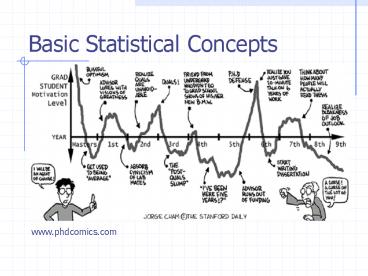Basic Statistical Concepts - PowerPoint PPT Presentation
Title:
Basic Statistical Concepts
Description:
Basic Statistical ... These statistical techniques are called descriptive statistics Distributions Recall a variable is a characteristic that can take different ... – PowerPoint PPT presentation
Number of Views:63
Avg rating:3.0/5.0
Title: Basic Statistical Concepts
1
Basic Statistical Concepts
www.phdcomics.com
2
So, you have collected your data
- Now what?
- We use statistical analysis to
- test our hypotheses
- make claims about the population
- This type of analyses are called inferential
statistics
3
But, first we must
- Organize, simplify, and describe our body of
data (distribution). - These statistical techniques are called
descriptive statistics
4
Distributions
- Recall a variable is a characteristic that can
take different values - A distribution of a variable is a summary of all
the different values of a variable - Both type (each value) and token (each instance)
5
Distribution
How excited are you about learning statistical
concepts? 1 2 3 4 5 6 7 Comatose
Hyperventilating
1
2
2
3
4
4
5
6
7
7 Types 1,2,3,4,5,6,7
9 Tokens 1,2,2,3,4,4,5,6,7
6
Distribution
2
1
1
2
3
4
5
6
7
N 9
7
Properties of a Distribution
- Shape
- symmetric vs. skewed
- unimodal vs. multimodal
- Central Tendency
- where most of the data are
- mean, median, and mode
- Variability (spread)
- how similar the scores are
- range, variance, and standard deviation
8
Representing a Distribution
- Often it is helpful to visually represent
distributions in various ways - Graphs
- continuous variables (histogram, line graph)
- categorical variables (pie chart, bar chart)
- Tables
- frequency distribution table
9
Distribution
- What if we collected 200 observations instead of
only 9?
10
Distribution
N 200
50
40
30
20
10
1
2
3
4
5
6
7
11
Continuous Variables
12
Categorical Variables
13
Frequency Distribution Table
14
Shape of a Distribution
- Symmetrical (normal)
- scores are evenly distributed about the central
tendency (i.e., mean)
15
Shape of a Distribution
- Skewed
- extreme high or low scores can skew the
distribution in either direction
Negative skew
Positive skew
16
Shape of a Distribution
- Unimodal
- Multimodal
Minor Mode
Major Mode
17
Distribution
- So, ordering our data and understanding the
shape of the distribution organizes our data - Now, we must simplify and describe the
distribution - What value best represents our distribution?
(central tendency)
18
Central Tendency
- Mode the most frequent score
- good for nominal scales (eye color)
- a must for multimodal distributions
- Median the middle score
- separates the bottom 50 and the top 50 of the
distribution - good for skewed distributions (net worth)
19
Central Tendency
- Mean the arithmetic average
- add all of the scores and divide by total number
of scores - This the preferred measure of central tendency
(takes all of the scores into account)
population
sample
20
Computing a Mean
10 scores 8, 4, 5, 2, 9, 13, 3, 7, 8, 5
?? 64
??/n 6.4
21
Central Tendency
- Is the mean always the best measure of central
tendency? - No, skew pulls the mean in the direction of the
skew
22
Central Tendency and Skew
Mode
Median
Mean
23
Central Tendency and Skew
Mode
Median
Mean
24
Distribution
- So, central tendency simplifies and describes
our distribution by providing a representative
score - What about the difference between the individual
scores and the mean? - (variability)
25
Variability
- Range maximum value minimum value
- only takes two scores from the distribution into
account - easily influenced by extreme high or low scores
- Standard Deviation/Variance
- the average deviation of scores from the mean of
the distribution - takes all scores into account
- less influenced by extreme values
26
Standard Deviation
- most popular and important measure of
variability - a measure of how far all of the individual
scores in the distribution are from a standard
(mean)
27
Standard Deviation
low variability small SD
high variability large SD
28
Computing a Standard Deviation
10 scores 8, 4, 5, 2, 9, 13, 3, 7, 8, 5
??/n 6.4
8 6.4 4 6.4 5 6.4 2 6.4 9 6.4
13 6.4 3 6.4 7 6.4 8 6.4 5
6.4
1.6 - 2.4 - 1.4 - 4.4 2.6 6.6 - 3.4 0.6
1.6 - 1.4
2.56 5.76 1.96 19.36 6.76 43.56 11.56
0.36 2.56 1.96
SS 96.4
10.71
3.27
29
Standard Deviation
- In a perfectly symmetrical (i.e. normal)
distribution 2/3 of the scores will fall within
/- 1 standard deviation
1
-1
6.4
9.67
3.13
30
Variance vs. SD
- So, SD simplifies and describes the distribution
by providing a measure of the variability of
scores - If we only ever report SD, then why would
variance be considered a separate measure of
variability? - Variance will be an important value in many
calculations in inferential statistics
31
Review
- Descriptive statistics organize, simplify, and
describe the important aspects of a distribution - This is the first step toward testing hypotheses
with inferential statistics - Distributions can be described in terms of
shape, central tendency, and variability - There are small differences in computation for
populations vs. samples - It is often useful to graphically represent a
distribution

